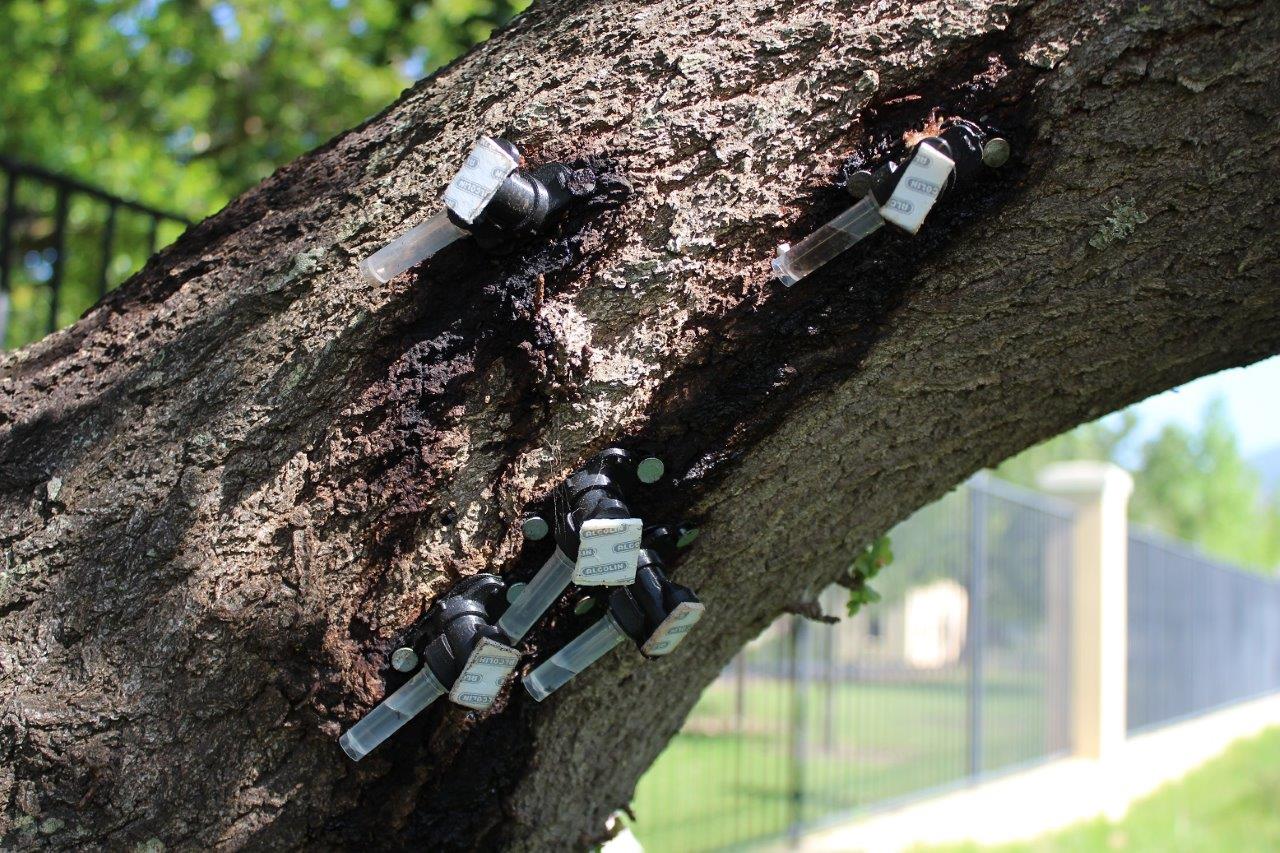An ongoing concern of tree-lovers is a dreaded pest known as the polyphagous shot hole borer beetle (PSHB). This tiny beetle bores into tree trunks, introducing a fungus that weakens and often kills the trees. This phenomenon has been causing devastation in gardens and forests since the beetle was discovered in South Africa in 2017.
However, initial research findings from Vergelegen Wine Estate in Somerset West, the site of an intensive three-year research project on the beetle, have generated some valuable insights:
- Researchers are better informed about the seasonal distribution of the beetle, which will help inform how to manage them;
- Chemical lures have been crucial in keeping bettle infestations low; and
- Pesticide injections into selected trees have slowed down beetle infection rates.
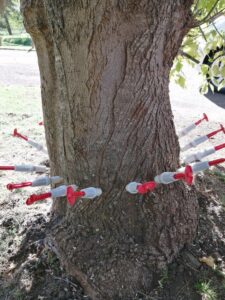
Chemical injections on an Oak tree at Vergelegen.
This is according to a research report from PhD candidate Heather Nependa from the Department of Conservation Ecology and Entomology in the Faculty of AgriScience at Stellenbosch University. Nependa is working under the guidance of Professor Francois Roets.
There are 14 infected trees at Vergelegen, says the estate’s Risk and Commercial Manager Leslie Naidoo. One English Oak, two Boxelders, two Trident Maples and one Japanese Maple have been treated.
Vergelegen is an ideal natural research lab as the 321-year-old estate is home to a vast collection of historic trees. Its history and biosphere are considered a microcosm of urban and peri-urban areas in South Africa, says Naidoo.
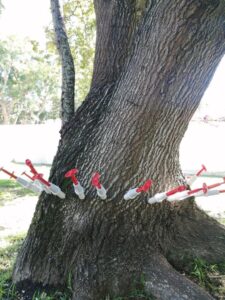
A Box Elder at Vergelegen with chemical injections.
Seasonal distribution
Vergelegen uses two trap types to monitor the beetles. One is a chemical lure in a plastic bottle, intended to repel beetles from trees. The other is a 3D-printed trap secured over holes made by beetles on infected trees, with steel mesh over each opening to prevent the pests from escaping.
Beetle counts held every two weeks at the chemical traps revealed a sharp increase in numbers during April and May, when about 500 beetles were collected at each inspection. These numbers began to decrease in June and July with about 10-20 beetles per inspection.
At the 3D traps, the first beetles also emerged in April and May.
“This data has been very valuable as we are now more informed about the seasonal distribution of the beetle, which will help inform how to manage them,” says Nependa.
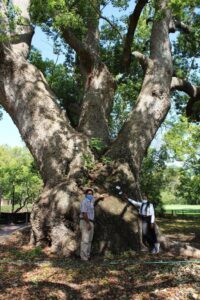
Vergelegen Risk and Commercial Manager Leslie Naidoo and researcher Heather Nependa at a giant camphor tree, fitted with repellent pouches.
Chemical lures
To further unravel beetle biology and behaviour, 50 plots (15mx10m) were set up around each chemical trap. Each tree in a plot was surveyed and many factors recorded, such as evaluating entry holes, sap flow and other signs of boring. These variables were first assessed in April and July and will take place every three months.
“Early results show that the use of quercivorol and verbenone (chemical lures) has been crucial in keeping PSHB infestations low, with only three out of 50 plots having PHSB infestations,” says Nependa.
Pesticide injections
She is also investigating the use of an insecticide, emamectin benzoate, and a fungicide, propiconazole.
The first set of these chemical injections was applied in February and March this year. Injected trees are monitored every 28 days, revealing that beetle infection rates have slowed in these trees, with not many more than 10 new holes observed.
The remainder of the chemical trial started in late October, both at Vergelegen and in the surrounding area. English Oak and London Plane trees are injected with either propiconazole, emamectin benzoate, or both.
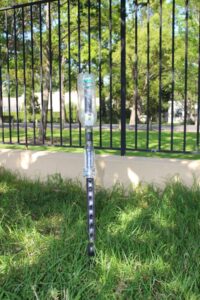
A plastic bottle trap fitted with a chemical lure, to divert beetles from the trees.
Lab preparation
In addition to these measures, a good deal of prep work has taken place in a Stellenbosch University lab. This includes breeding beetles to test their colonisation of chemically treated trees. There are currently 10 active colonies from which live beetles will be collected. A symbiotic fungus (Fusarium euwallacea) is also being grown in the lab. This will be innoculated into the chemically treated trees to measure the effect of the chemicals on fungus growth.
Satellite imagery
Predicting the economic impact of the beetle also requires remote sensing work. This is largely desktop-based, using satellite images taken in 2019 and 2020.
“The imagery is used in machine learning models, which are being trained to distinguish between evergreen and deciduous trees, and infected and non-infected trees.
“This data is used to produce classified maps, after which a time-series analysis will provide more insight into how trees respond to various infestation levels, and how this ultimately impacts or changes tree functioning and their ecosystem services. Monitoring these changes over time will help inform early detection procedures,” says Nependa.
Measuring fungal growth
Further lab work involves experiments to measure fungal growth rates in various nutritional mediums, which are adjusted with carbon and nitrogen.
“Carbon and nitrogen were selected because they are readily available in host trees and their quantities in host trees reflect the health of the host. Carbon measures usually indicate water stress, while nitrogen measures pollutants in the environment. They also affect how the fungus – and in turn the beetles – will develop,” says Nependa.
Isotope analysis
An isotope analysis experiment is also being conducted with the help of the Stable Light Isotope Laboratory in the University of Cape Town’s archaeology department. Wood samples have been collected from two beetle reproductive hosts, English Oak and London Plane trees, and two non-reproductive hosts, Wild Olive and Camphor trees.
“These trees represent different levels of stress and will hopefully give an indication of what kind of stress the trees are under. After the isotope evaluation, the selected trees will be used in beetle development and fungal growth experiments.”
Research continues until June 2022, says Naidoo. Findings will be shared via Stellenbosch University’s Department of Conservation Ecology and Entomology.
“Trees provide so many benefits, from their natural beauty to helping to stop climate change. We are delighted that Vergelegen can play a role in helping to find out more about this pest, so that we can protect our precious arboreal heritage.”
Source: Meropa Communications

